Jet Impingement Cooling of a Rotating Hot Circular Cylinder with Hybrid Nanofluid under Multiple Magnetic Field Effects
Abstract
:1. Introduction
2. Mathematical Model
- At the inlet,.
- At the exit:
- Top and bottom plate are adiabatic and stationary:
- On the rotating cylinder surface:
- At the interface between the upper and lower domains:
3. Results and Discussion
3.1. Computational Fluid Dynamics Simulation Results
3.2. Modal Approach for Analyzing the Heat Transfer Dynamics
4. Conclusions
- The coupled interactions between the rotating hot body, forced flow of hybrid nanofluid and multiple magnetic field effects determine the flow recirculations with the systems and heat transfer enhancement amounts.
- When the rotational surface effects are dominant, the impacts of Re on the average Nu increase become weak as compared to motionless cylinder case. When the lowest and highest Re cases were compared, a 5% rise of average Nu was seen at Rew = 800, and it was 48.5% at Rew = 0.
- Impacts of rotation on the HT enhancement are significant when MaF effects are present in the system. The average Nu rose by about 249% at Ha1 = 0, and it was only 175% at Ha1 = 0.
- When the configuration in the presence of MaF effects at the highest strength is compared with the case in the absence of MaF in both domains, a 54.5% reduction in the average Nu was obtained.
- When cases with the smallest and highest cylinder sizes were compared at the highest rotational speeds, the increment in the average Nu was observed as 23.5%.
- The optimum value of distance between the opposing jets was obtained at H = 14 w for the maximum HT, where a 54.5% rise in the average Nu was attained as compared to the case at the smallest spacing.
- A modal analysis of the local Nu was proposed with 20-modes, with varying Re, Rew and Ha parameters.
Author Contributions
Funding
Institutional Review Board Statement
Informed Consent Statement
Conflicts of Interest
Abbreviations
| B | magnetic field strength |
| CC | cumulative contribution |
| c | mode coefficient |
| D | hydraulic diameter |
| h | local heat transfer coefficient |
| H | distance between the jet and interface |
| Ha | Hartmann number |
| k | thermal conductivity |
| L | plate length |
| n | surface normal |
| Nu | Nusselt number |
| p | pressure |
| Pm | mode number |
| Pr | Prandtl number |
| Rew | rotational Reynolds number |
| Re | Reynolds number |
| r | cylinder radius |
| T | temperature |
| u, v | x-y velocity components |
| W | weight function |
| x, y | Cartesian coordinates |
| x, y | cylinder center |
| Greek Characters | |
| thermal diffusivity | |
| solid volume fraction | |
| kinematic viscosity | |
| non-dimensional temperature | |
| density of the fluid | |
| inclination angle | |
| Subscripts | |
| c | cold |
| h | hot |
| m | average |
| nf | nanofluid |
| p | solid particle |
References
- Garimella, S.V. Heat transfer and flow fields in confined jet impingement. Annu. Rev. Heat Transf. 2000, 11, 413–494. [Google Scholar] [CrossRef]
- Jambunathan, K.; Lai, E.; Moss, M.; Button, B. A review of heat transfer data for single circular jet impingement. Int. J. Heat Fluid Flow 1992, 13, 106–115. [Google Scholar] [CrossRef]
- Sarkar, A.; Nitin, N.; Karwe, M.; Singh, R.P. Fluid flow and heat transfer in air jet impingement in food processing. J. Food Sci. 2004, 69, CRH113–CRH122. [Google Scholar] [CrossRef]
- Nadda, R.; Kumar, A.; Maithani, R. Efficiency improvement of solar photovoltaic/solar air collectors by using impingement jets: A review. Renew. Sustain. Energy Rev. 2018, 93, 331–353. [Google Scholar] [CrossRef]
- Sajid, M.U.; Ali, H.M. Recent advances in application of nanofluids in heat transfer devices: A critical review. Renew. Sustain. Energy Rev. 2019, 103, 556–592. [Google Scholar] [CrossRef]
- Pordanjani, A.H.; Aghakhani, S.; Afrand, M.; Mahmoudi, B.; Mahian, O.; Wongwises, S. An updated review on application of nanofluids in heat exchangers for saving energy. Energy Convers. Manag. 2019, 198, 111886. [Google Scholar] [CrossRef]
- Khanafer, K.; Vafai, K. A review on the applications of nanofluids in solar energy field. Renew. Energy 2018, 123, 398–406. [Google Scholar] [CrossRef]
- Aly, A.M.; Mohamed, E.M.; Alsedais, N. The magnetic field on a nanofluid flow within a finned cavity containing solid particles. Case Stud. Therm. Eng. 2021, 25, 100945. [Google Scholar] [CrossRef]
- Kakaç, S.; Pramuanjaroenkij, A. Single-phase and two-phase treatments of convective heat transfer enhancement with nanofluids–A state-of-the-art review. Int. J. Therm. Sci. 2016, 100, 75–97. [Google Scholar] [CrossRef]
- Ahmed, F. Experimental investigation of Al2O3-water nanofluid as a secondary fluid in a refrigeration system. Case Stud. Therm. Eng. 2021, 101024. [Google Scholar] [CrossRef]
- Kareem, Z.S.; Balla, H.H.; AbdulWahid, A.F. Heat transfer enhancement in single circular impingement jet by CuO-water nanofluid. Case Stud. Therm. Eng. 2019, 15, 100508. [Google Scholar] [CrossRef]
- Manca, O.; Mesolella, P.; Nardini, S.; Ricci, D. Numerical study of a confined slot impinging jet with nanofluids. Nanoscale Res. Lett. 2011, 6, 1–16. [Google Scholar] [CrossRef] [Green Version]
- Barewar, S.D.; Tawri, S.; Chougule, S.S. Heat transfer characteristics of free nanofluid impinging jet on flat surface with different jet to plate distance: An experimental investigation. Chem. Eng. Process.-Process. Intensif. 2019, 136, 1–10. [Google Scholar] [CrossRef]
- Lamraoui, H.; Mansouri, K.; Saci, R. Numerical investigation on fluid dynamic and thermal behavior of a non-Newtonian Al2O3–water nanofluid flow in a confined impinging slot jet. J. Non-Newton. Fluid Mech. 2019, 265, 11–27. [Google Scholar] [CrossRef]
- Balla, H.H.; Hashem, A.L.; Kareem, Z.S.; Abdulwahid, A.F. Heat transfer potentials of ZnO/water nanofluid in free impingement jet. Case Stud. Therm. Eng. 2021, 27, 101143. [Google Scholar] [CrossRef]
- Mohammadpour, J.; Lee, A. Investigation of nanoparticle effects on jet impingement heat transfer: A review. J. Mol. Liq. 2020, 316, 113819. [Google Scholar] [CrossRef]
- Teamah, M.A.; Dawood, M.M.K.; Shehata, A. Numerical and experimental investigation of flow structure and behavior of nanofluids flow impingement on horizontal flat plate. Exp. Therm. Fluid Sci. 2016, 74, 235–246. [Google Scholar] [CrossRef]
- Naphon, P.; Wiriyasart, S. Pulsating flow and magnetic field effects on the convective heat transfer of TiO2-water nanofluids in helically corrugated tube. Int. J. Heat Mass Transf. 2018, 125, 1054–1060. [Google Scholar] [CrossRef]
- Buonomo, B.; Manca, O.; Bondareva, N.S.; Sheremet, M.A. Thermal and fluid dynamic behaviors of confined slot jets impinging on an isothermal moving surface with nanofluids. Energies 2019, 12, 2074. [Google Scholar] [CrossRef] [Green Version]
- Selimefendigil, F.; Öztop, H.F. Numerical study and identification of cooling of heated blocks in pulsating channel flow with a rotating cylinder. Int. J. Therm. Sci. 2014, 79, 132–145. [Google Scholar] [CrossRef]
- Akdag, U.; Akcay, S.; Demiral, D. Heat transfer enhancement with laminar pulsating nanofluid flow in a wavy channel. Int. Commun. Heat Mass Transf. 2014, 59, 17–23. [Google Scholar] [CrossRef]
- Mitra, S.; Saha, S.K.; Chakraborty, S.; Das, S. Study on boiling heat transfer of water–TiO2 and water–MWCNT nanofluids based laminar jet impingement on heated steel surface. Appl. Therm. Eng. 2012, 37, 353–359. [Google Scholar] [CrossRef]
- Liu, Z.H.; Qiu, Y.H. Boiling heat transfer characteristics of nanofluids jet impingement on a plate surface. Heat Mass Transf. 2007, 43, 699–706. [Google Scholar] [CrossRef]
- Li, P.; Guo, D.; Liu, R. Mechanism analysis of heat transfer and flow structure of periodic pulsating nanofluids slot-jet impingement with different waveforms. Appl. Therm. Eng. 2019, 152, 937–945. [Google Scholar] [CrossRef]
- Mahdavi, M.; Sharifpur, M.; Meyer, J.P. Fluid flow and heat transfer analysis of nanofluid jet cooling on a hot surface with various roughness. Int. Commun. Heat Mass Transf. 2020, 118, 104842. [Google Scholar] [CrossRef]
- Singh, T.P.; Kumar, A.; Satapathy, A.K. Role of a Sinusoidal Wavy Surface in Enhancement of Heat Transfer Using Turbulent Dual Jet. J. Heat Transf. 2021, 143, 032002. [Google Scholar] [CrossRef]
- Selimefendigil, F.; Öztop, H.F. Forced convection and thermal predictions of pulsating nanofluid flow over a backward facing step with a corrugated bottom wall. Int. J. Heat Mass Transf. 2017, 110, 231–247. [Google Scholar] [CrossRef]
- Roslan, R.; Saleh, H.; Hashim, I. Effect of rotating cylinder on heat transfer in a square enclosure filled with nanofluids. Int. J. Heat Mass Transf. 2012, 55, 7247–7256. [Google Scholar] [CrossRef]
- Khanafer, K.; Aithal, S.M.; Vafai, K. Mixed convection heat transfer in a differentially heated cavity with two rotating cylinders. Int. J. Therm. Sci. 2019, 135, 117–132. [Google Scholar] [CrossRef]
- Selimefendigil, F.; Oztop, H.F. Analysis and predictive modeling of nanofluid-jet impingement cooling of an isothermal surface under the influence of a rotating cylinder. Int. J. Heat Mass Transf. 2018, 121, 233–245. [Google Scholar]
- Benim, A.C.; Ozkan, K.; Cagan, M.; Gunes, D. Computational investigation of turbulent jet impinging onto rotating disk. Int. J. Numer. Methods Heat Fluid Flow 2007, 17, 284–301. [Google Scholar] [CrossRef]
- Jeng, T.M.; Tzeng, S.C.; Xu, R. Heat transfer characteristics of a rotating cylinder with a lateral air impinging jet. Int. J. Heat Mass Transf. 2014, 70, 235–249. [Google Scholar] [CrossRef]
- Scheichl, B.; Kluwick, A. Laminar spread of a circular liquid jet impinging axially on a rotating disc. J. Fluid Mech. 2019, 864, 449–489. [Google Scholar] [CrossRef] [Green Version]
- Chen, Y.M.; Wang, K.C. Experimental study on the forced convective flow in a channel with heated blocks in tandem. Exp. Therm. Fluid Sci. 1998, 16, 286–298. [Google Scholar] [CrossRef]
- Kabeel, A.; El-Said, E.M.; Dafea, S. A review of magnetic field effects on flow and heat transfer in liquids: Present status and future potential for studies and applications. Renew. Sustain. Energy Rev. 2015, 45, 830–837. [Google Scholar] [CrossRef]
- Sheikholeslami, M.; Rokni, H.B. Magnetohydrodynamic CuO–water nanofluid in a porous complex-shaped enclosure. J. Therm. Sci. Eng. Appl. 2017, 9, 041007. [Google Scholar] [CrossRef]
- Nesliturk, A.I.; Tezer-Sezgin, M. The finite element method for MHD flow at high Hartmann numbers. Comput. Methods Appl. Mech. Eng. 2005, 194, 1201–1224. [Google Scholar] [CrossRef] [Green Version]
- Nguyen, T.T.; Bouillault, F.; Daniel, L.; Mininger, X. Finite element modeling of magnetic field sensors based on nonlinear magnetoelectric effect. J. Appl. Phys. 2011, 109, 084904. [Google Scholar] [CrossRef] [Green Version]
- Lee, S.H.; Kim, Y.S. Finite element analysis for cooling effect of magnetic fluid with alternating magnetic field. J. Appl. Phys. 2009, 105, 07B510. [Google Scholar] [CrossRef]
- Selimefendigil, F.; Öztop, H.F. Corrugated conductive partition effects on MHD free convection of CNT-water nanofluid in a cavity. Int. J. Heat Mass Transf. 2019, 129, 265–277. [Google Scholar] [CrossRef]
- Ansari, S.; Farquharson, C.G. 3D finite-element forward modeling of electromagnetic data using vector and scalar potentials and unstructured grids. Geophysics 2014, 79, E149–E165. [Google Scholar] [CrossRef]
- Yin, W.; Lu, M.; Yin, L.; Zhao, Q.; Meng, X.; Zhang, Z.; Peyton, A. Acceleration of eddy current computation for scanning probes. Insight-Non-Destr. Test. Cond. Monit. 2018, 60, 547–555. [Google Scholar] [CrossRef]
- Huang, R.; Lu, M.; Peyton, A.; Yin, W. A novel perturbed matrix inversion based method for the acceleration of finite element analysis in crack-scanning eddy current NDT. IEEE Access 2020, 8, 12438–12444. [Google Scholar] [CrossRef]
- Kumar, M.A.; Reddy, Y.D.; Rao, V.S.; Goud, B.S. Thermal radiation impact on MHD heat transfer natural convective nano fluid flow over an impulsively started vertical plate. Case Stud. Therm. Eng. 2021, 24, 100826. [Google Scholar] [CrossRef]
- Ghasemi, B.; Aminossadati, S.; Raisi, A. Magnetic field effect on natural convection in a nanofluid-filled square enclosure. Int. J. Therm. Sci. 2011, 50, 1748–1756. [Google Scholar] [CrossRef]
- Waqas, H.; Farooq, U.; Naseem, R.; Hussain, S.; Alghamdi, M. Impact of MHD radiative flow of hybrid nanofluid over a rotating disk. Case Stud. Therm. Eng. 2021, 26, 101015. [Google Scholar] [CrossRef]
- Sheremet, M.A.; Oztop, H.; Pop, I.; Al-Salem, K. MHD free convection in a wavy open porous tall cavity filled with nanofluids under an effect of corner heater. Int. J. Heat Mass Transf. 2016, 103, 955–964. [Google Scholar] [CrossRef]
- Ma, Y.; Mohebbi, R.; Rashidi, M.M.; Yang, Z. MHD convective heat transfer of Ag-MgO/water hybrid nanofluid in a channel with active heaters and coolers. Int. J. Heat Mass Transf. 2019, 137, 714–726. [Google Scholar] [CrossRef]
- Khalid, A.; Khan, I.; Khan, A.; Shafie, S.; Tlili, I. Case study of MHD blood flow in a porous medium with CNTS and thermal analysis. Case Stud. Therm. Eng. 2018, 12, 374–380. [Google Scholar] [CrossRef]
- Kolsi, L.; Alrashed, A.A.A.A.; Al-Salem, K.; Oztop, H.F.; Borjini, M.N. Control of natural convection via inclined plate of CNT-water nanofluid in an open sided cubical enclosure under magnetic field. Int. J. Heat Mass Transf. 2017, 111, 1007–1018. [Google Scholar] [CrossRef]
- Naphon, P.; Wiriyasart, S. Pulsating TiO2/water nanofluids flow and heat transfer in the spirally coiled tubes with different magnetic field directions. Int. J. Heat Mass Transf. 2017, 115, 537–543. [Google Scholar] [CrossRef]
- Sheikholeslami, M.; Mahian, O. Enhancement of PCM solidification using inorganic nanoparticles and an external magnetic field with application in energy storage systems. J. Clean. Prod. 2019, 215, 963–977. [Google Scholar] [CrossRef]
- Aidaoui, L.; Lasbet, Y.; Selimefendigil, F. Improvement of transfer phenomena rates in open chaotic flow of nanofluid under the effect of magnetic field: Application of a combined method. Int. J. Mech. Sci. 2020, 179, 105649. [Google Scholar] [CrossRef]
- Lee, H.; Ha, M.; Yoon, H. A numerical study on the fluid flow and heat transfer in the confined jet flow in the presence of magnetic field. Int. J. Heat Mass Transf. 2005, 48, 5297–5309. [Google Scholar] [CrossRef]
- Nishiyama, H.; Kuzuhara, M.; Solonenko, O.; Kamiyama, S. Numerical modeling of an impinging and compressible dusted plasma jet controlled by a magnetic field. Plasma Chem. Plasma Process. 1999, 19, 363–381. [Google Scholar] [CrossRef]
- Selimefendigil, F.; Öztop, H.F. Al2O3-water nanofluid jet impingement cooling with magnetic field. Heat Transf. Eng. 2020, 41, 50–64. [Google Scholar] [CrossRef]
- Nimmagadda, R.; Haustein, H.D.; Asirvatham, L.G.; Wongwises, S. Effect of uniform/non-uniform magnetic field and jet impingement on the hydrodynamic and heat transfer performance of nanofluids. J. Magn. Magn. Mater. 2019, 479, 268–281. [Google Scholar] [CrossRef]
- Abbassi, H.; Nassrallah, S.B. MHD flow and heat transfer in a backward-facing step. Int. Commun. Heat Mass Transf. 2007, 34, 231–237. [Google Scholar] [CrossRef]
- Hussain, S.; Ahmed, S.E. Unsteady MHD forced convection over a backward facing step including a rotating cylinder utilizing Fe3O4-water ferrofluid. J. Magn. Magn. Mater. 2019, 484, 356–366. [Google Scholar] [CrossRef]
- Selimefendigil, F.; Öztop, H.F. Hydro-thermal performance of CNT nanofluid in double backward facing step with rotating tube bundle under magnetic field. Int. J. Mech. Sci. 2020, 185, 105876. [Google Scholar] [CrossRef]
- Urmi, W.; Rahman, M.; Hamzah, W. An experimental investigation on the thermophysical properties of 40% ethylene glycol based TiO2-Al2O3 hybrid nanofluids. Int. Commun. Heat Mass Transf. 2020, 116, 104663. [Google Scholar] [CrossRef]
- Sahoo, D.; Sharif, M. Numerical modeling of slot-jet impingement cooling of a constant heat flux surface confined by a parallel wall. Int. J. Therm. Sci. 2004, 43, 877–887. [Google Scholar] [CrossRef]
- Chou, Y.; Hung, Y. Impingement cooling of an isothermally heated surface with a confined slot jet. ASME Trans. J. Heat Transf. 1994, 116, 479–482. [Google Scholar] [CrossRef]
- Manca, O.; Ricci, D.; Nardini, S.; Di Lorenzo, G. Thermal and fluid dynamic behaviors of confined laminar impinging slot jets with nanofluids. Int. Commun. Heat Mass Transf. 2016, 70, 15–26. [Google Scholar] [CrossRef]
- Zhang, T.; Che, D. Double MRT thermal lattice Boltzmann simulation for MHD natural convection of nanofluids in an inclined cavity with four square heat sources. Int. J. Heat Mass Transf. 2016, 94, 87–100. [Google Scholar] [CrossRef]
- Berkooz, G.; Lumley, P.H.J.L. The proper orthogonal decomposition in the analysis of turbulent flows. Annu. Rev. Fluid Mech. 1993, 25, 539–575. [Google Scholar] [CrossRef]
- Sirisup, S.; Karniadakis, G.E. Stability and accuracy of periodic flow solutions obtained by a POD-penalty method. J. Phys. D 2005, 202, 218–237. [Google Scholar] [CrossRef]
- Hasan, N.; Sanghi, S. Proper orthogonal decomposition and low-dimensional modelling of thermally driven two-dimensional flow in a horizontal rotating flow. J. Fluid Mech. 2007, 573, 265–295. [Google Scholar] [CrossRef]
- Selimefendigil, F.; Polifke, W. Nonlinear, proper-orthogonal-decomposition-based model of forced convection heat transfer in pulsating flow. AIAA J. 2014, 52, 131–145. [Google Scholar] [CrossRef]
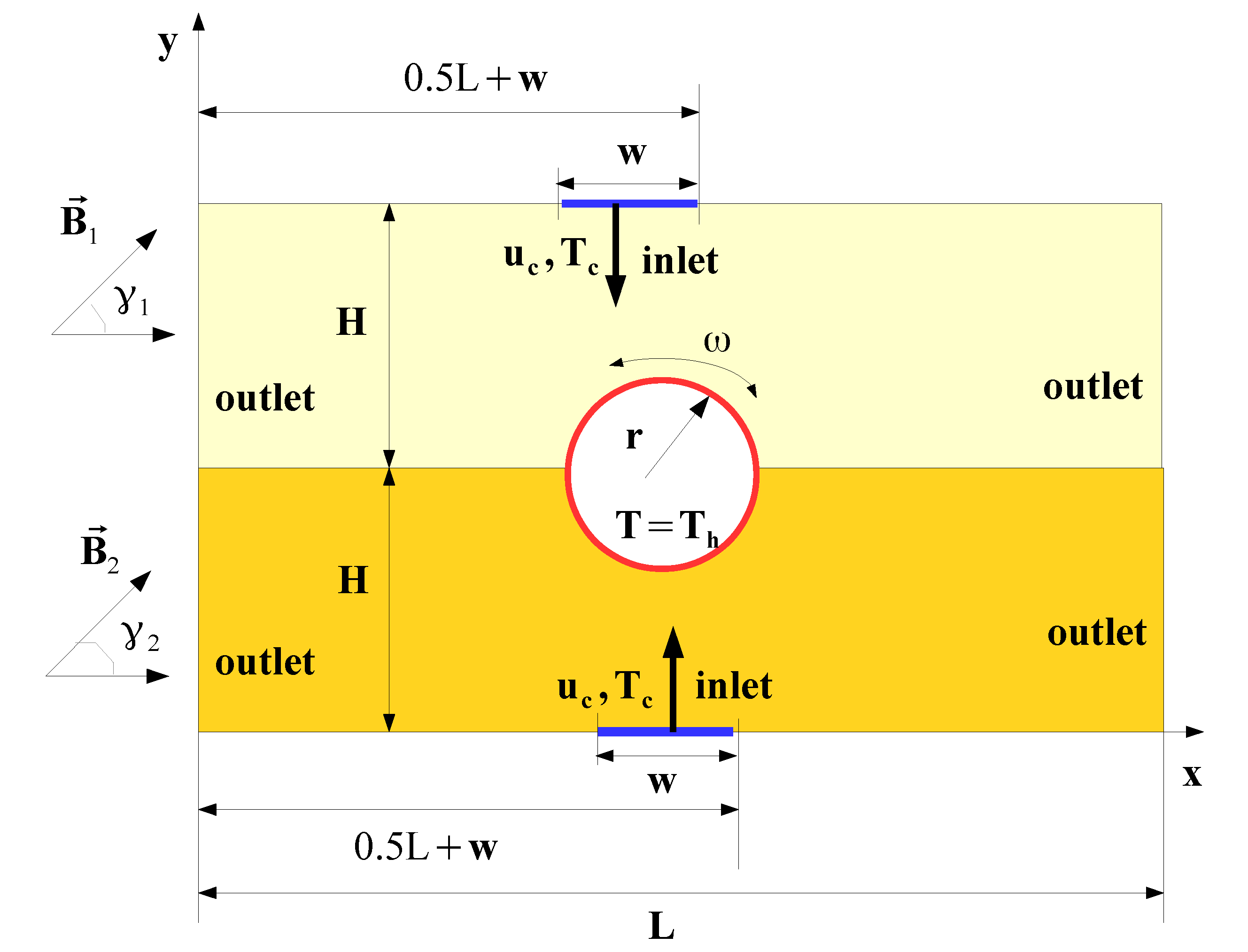
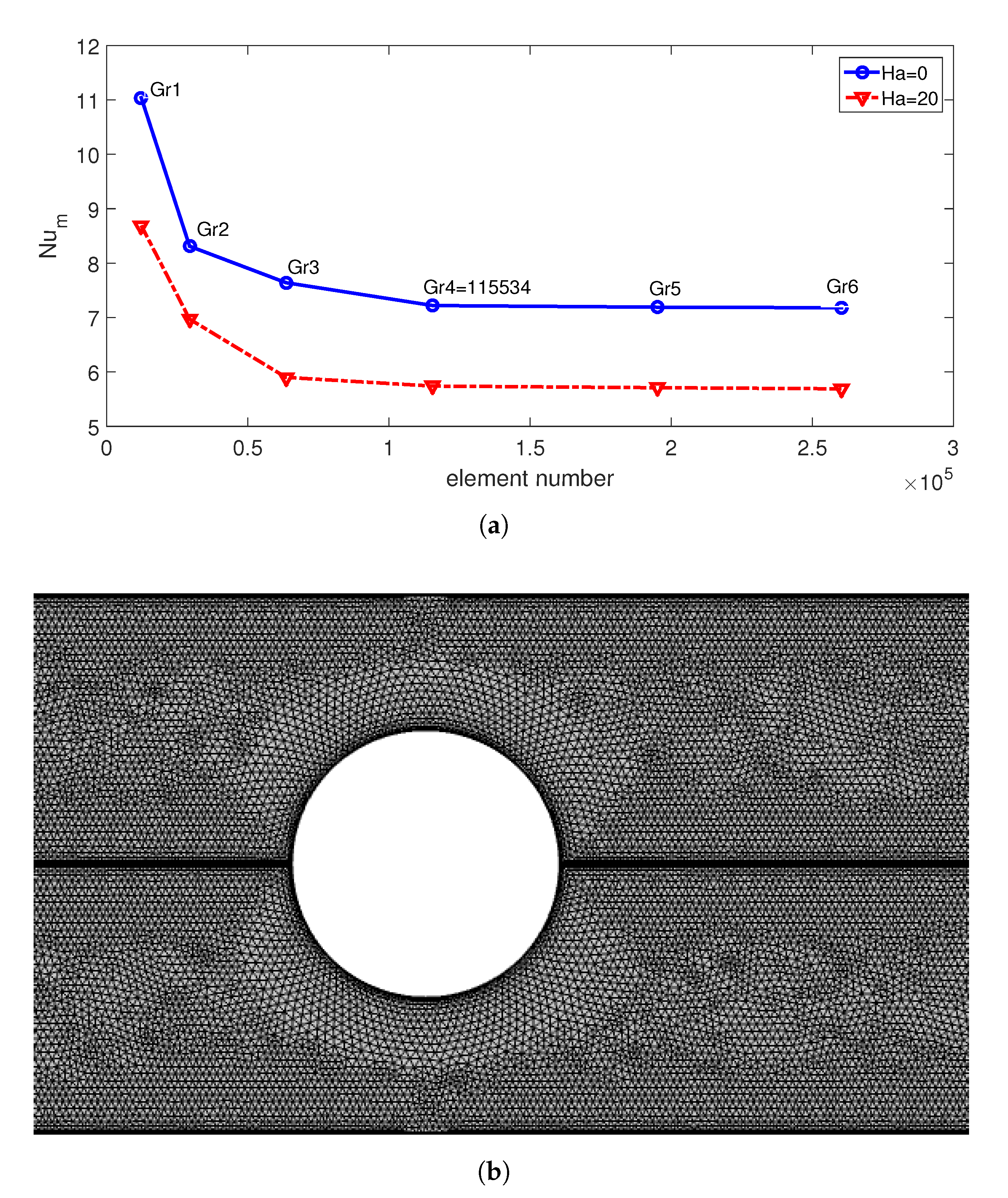

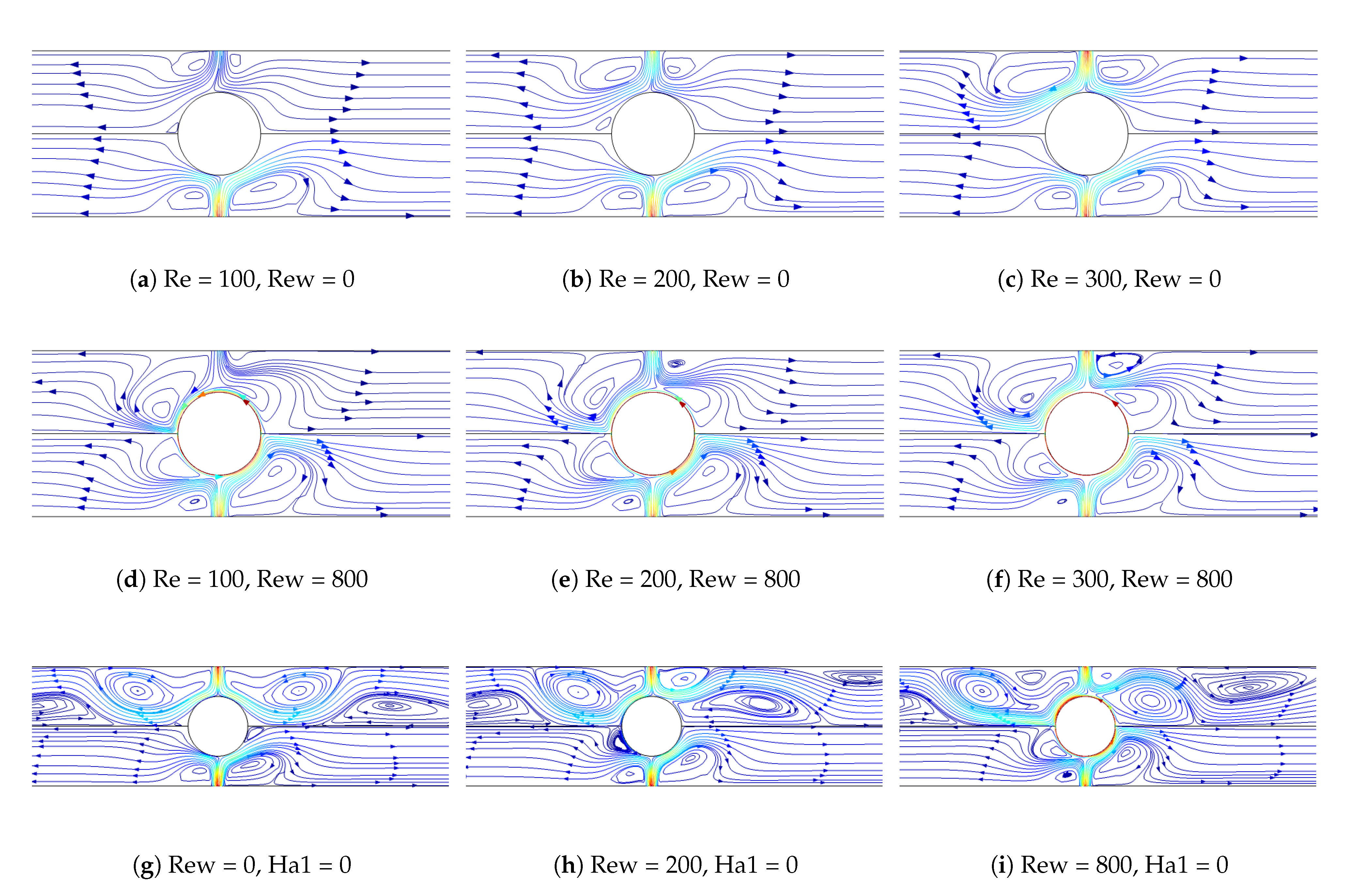
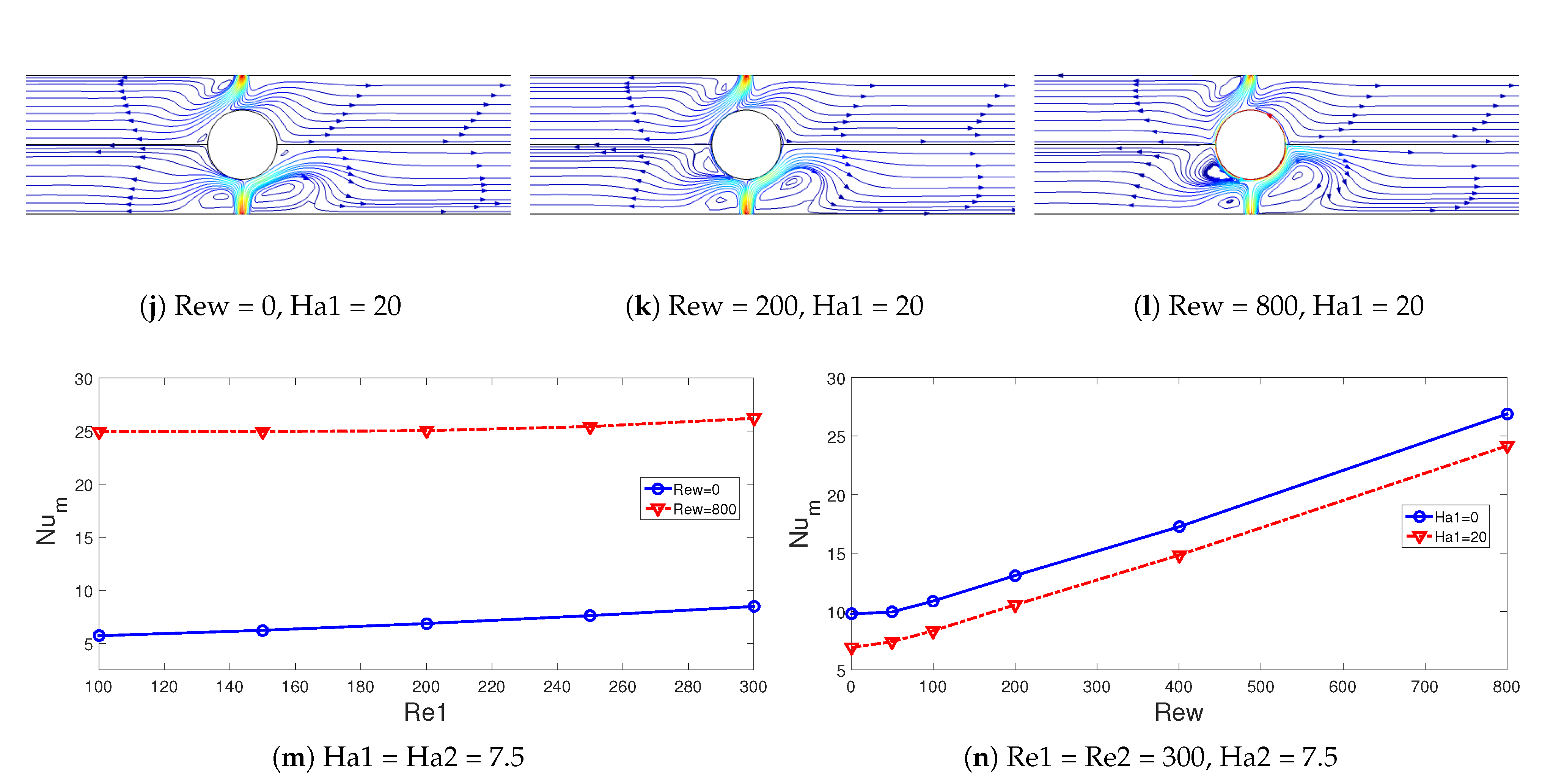

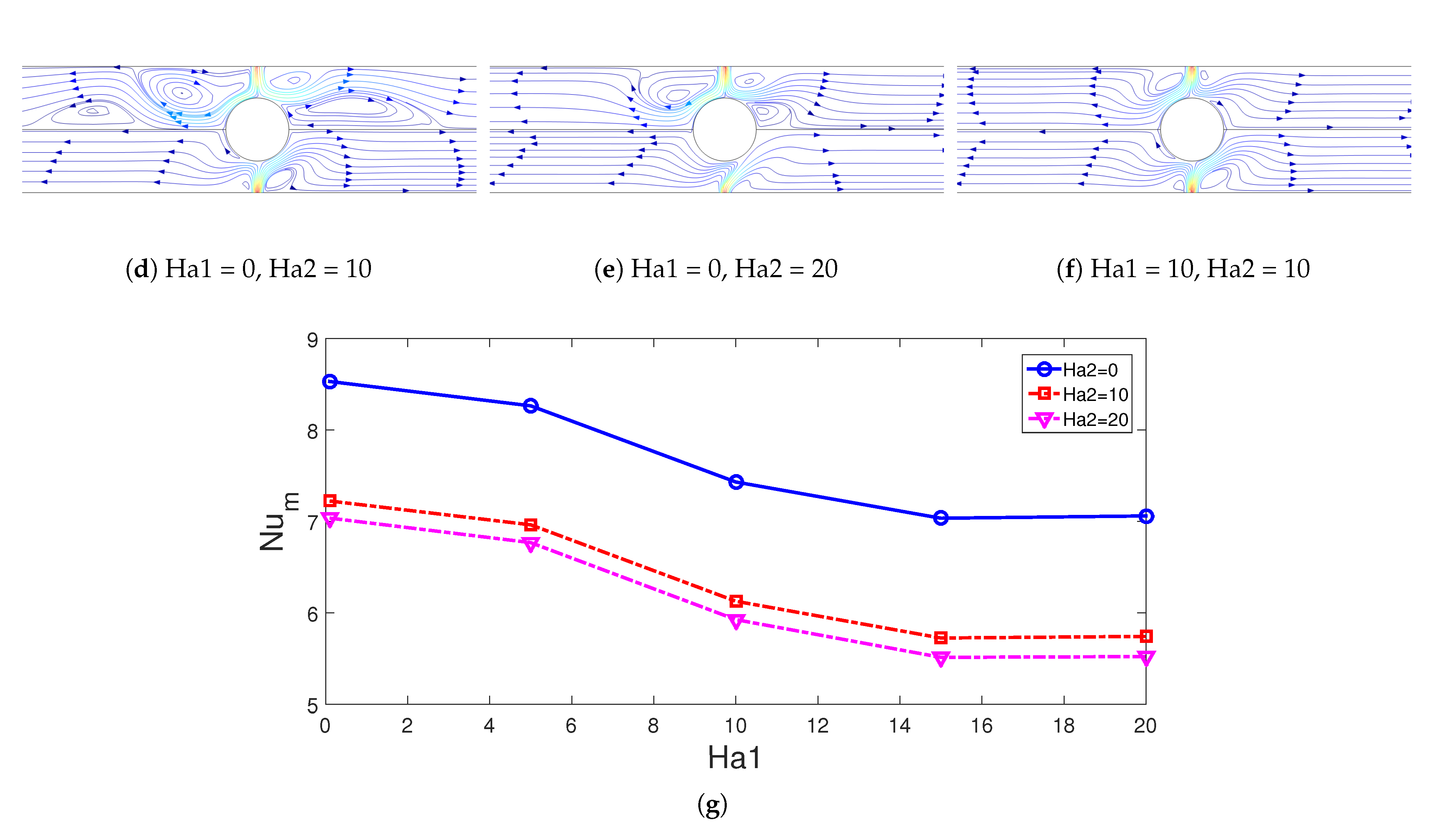
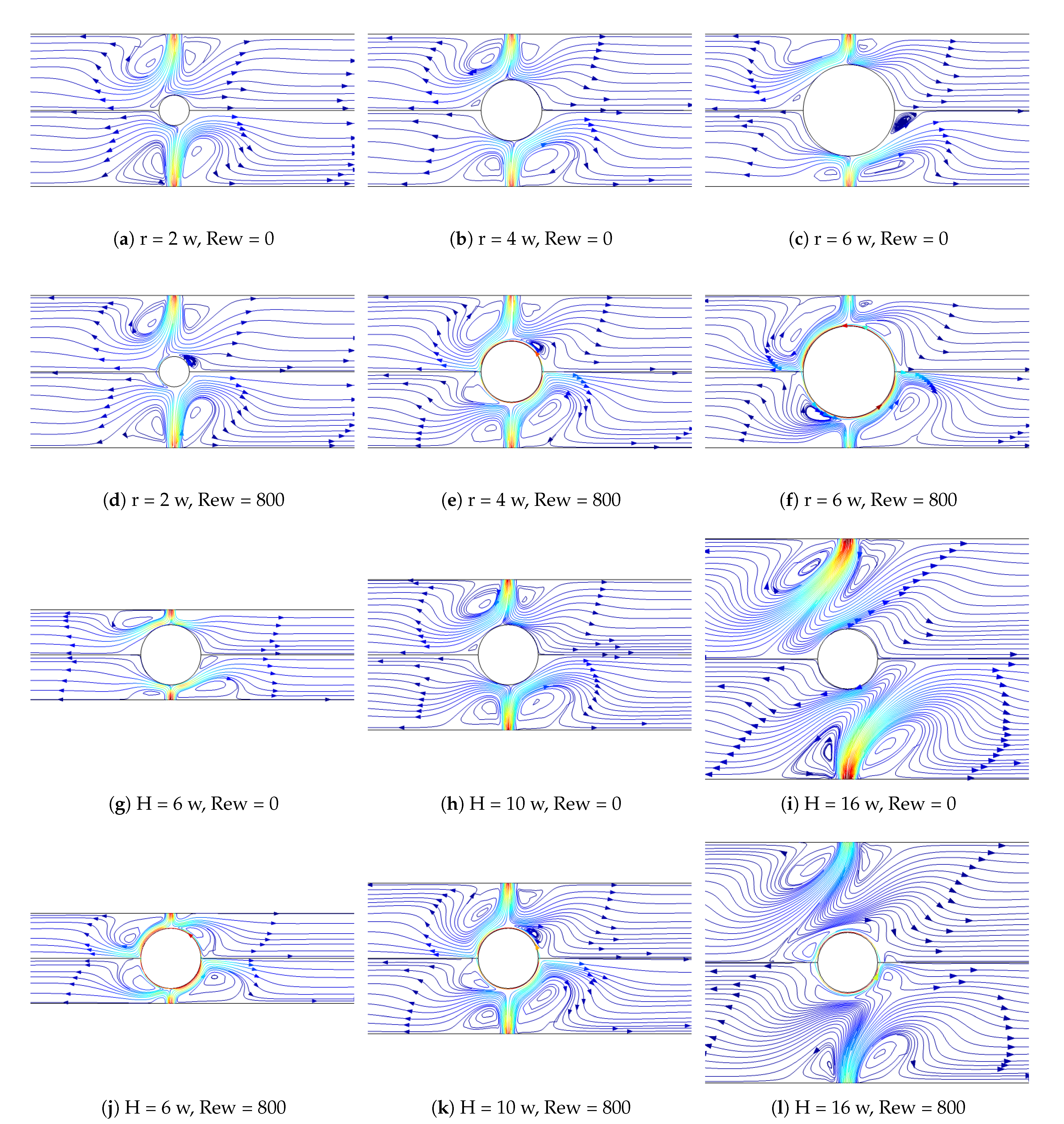
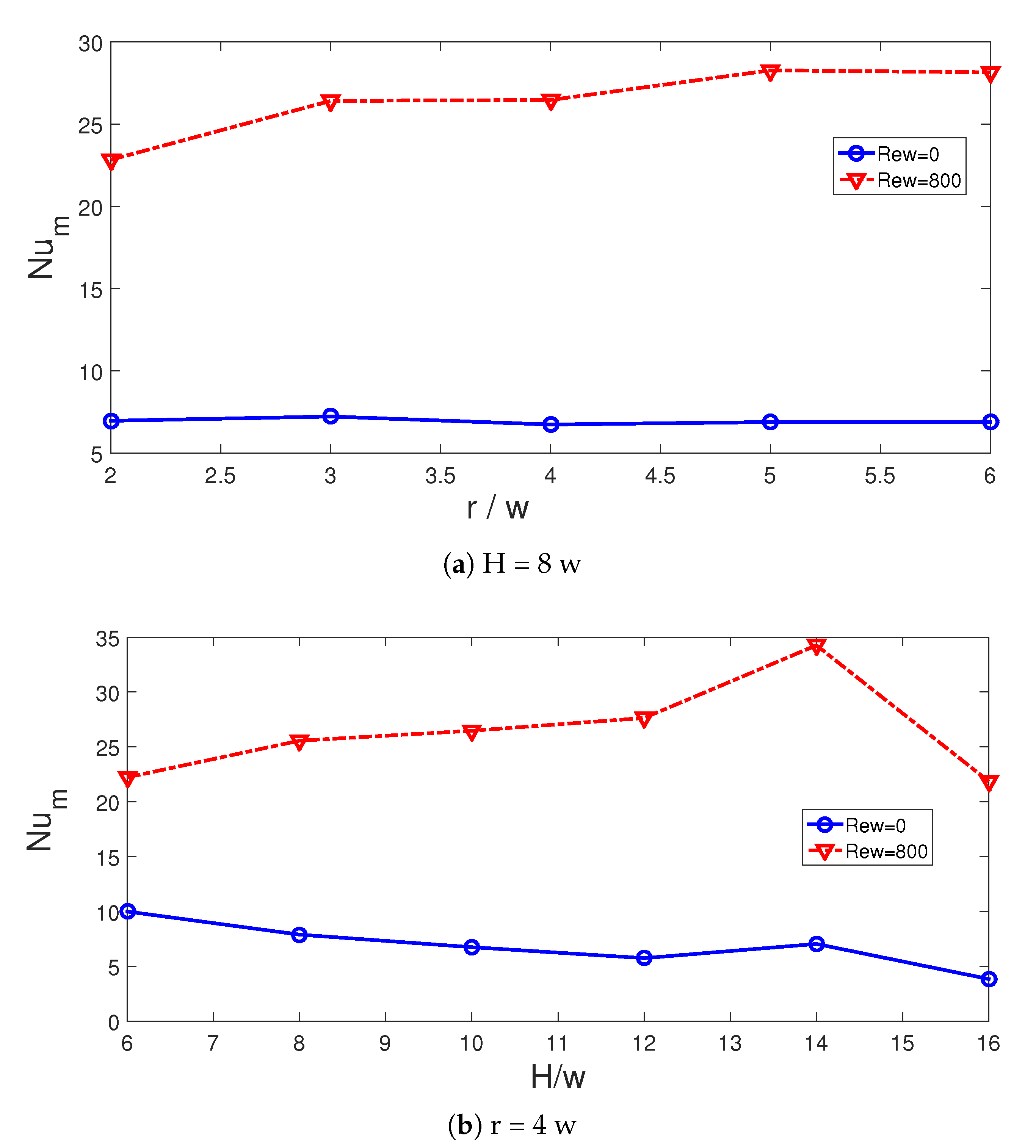
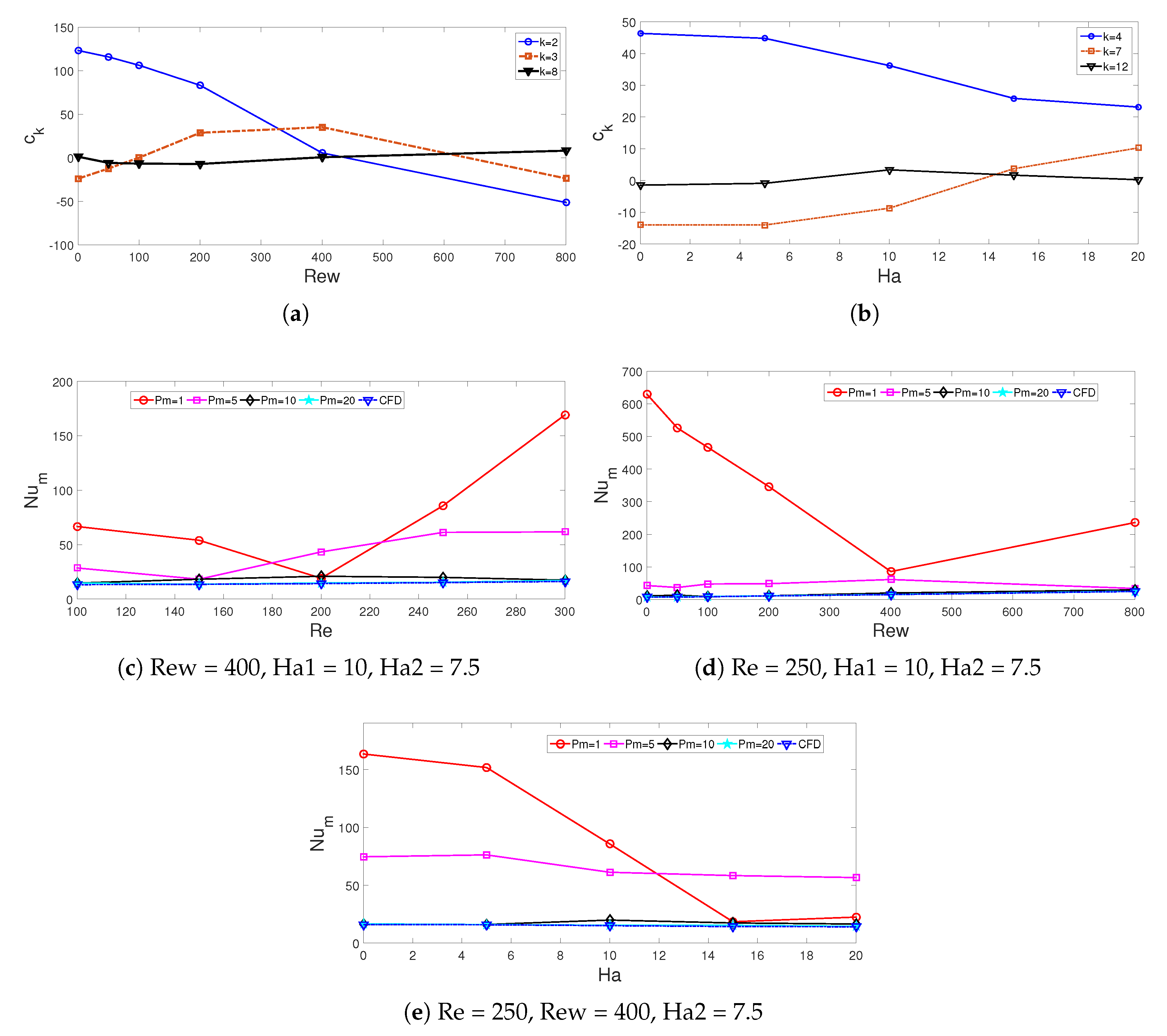
| Reference Study | Re = 300 |
|---|---|
| Present study | 9.81 |
| Ref. [63] | 9.85 |
| Ref. [64] | 9.66 |
| Re | Ha | Rew | Nm (CFD) | Nm (Pm = 20) | Nm (Pm = 10) | Nm (Pm = 5) | Nm (Pm = 1) |
|---|---|---|---|---|---|---|---|
| 100.0000 | 0 | 0 | 6.2497 | 6.4462 | 9.5632 | 57.3214 | 545.8495 |
| 100.0000 | 0 | 50.0000 | 6.8237 | 7.1213 | 11.9184 | 17.3907 | 462.4441 |
| 100.0000 | 0 | 400.0000 | 14.6884 | 14.9741 | 18.6315 | 28.1527 | 80.9423 |
| 100.0000 | 0 | 800.0000 | 24.5434 | 25.5128 | 31.3278 | 79.0200 | 200.1170 |
| 100.0000 | 10.0000 | 0 | 5.6470 | 5.9361 | 7.1699 | 49.7720 | 493.4111 |
| 100.0000 | 10.0000 | 100.0000 | 6.8706 | 6.9632 | 10.2770 | 7.4057 | 308.0403 |
| 100.0000 | 10.0000 | 200.0000 | 8.8338 | 8.8570 | 8.9427 | 44.0794 | 179.6151 |
| 100.0000 | 10.0000 | 800.0000 | 23.9908 | 24.1325 | 29.1065 | 83.9645 | 259.1009 |
| 100.0000 | 20.0000 | 0 | 5.4673 | 5.5938 | 5.9929 | 54.9489 | 477.0083 |
| 100.0000 | 20.0000 | 50.0000 | 6.0726 | 6.2576 | 7.0391 | 12.4069 | 391.0110 |
| 100.0000 | 20.0000 | 100.0000 | 6.8875 | 6.9375 | 8.2319 | 15.3442 | 308.9107 |
| 100.0000 | 20.0000 | 200.0000 | 8.7475 | 8.8960 | 8.7819 | 49.1804 | 167.7980 |
| 100.0000 | 20.0000 | 400.0000 | 12.6457 | 12.9282 | 17.9019 | 22.0853 | 122.6875 |
| 100.0000 | 20.0000 | 800.0000 | 21.6047 | 21.9554 | 32.6789 | 65.2207 | 469.4697 |
| 200.0000 | 0 | 0 | 7.8387 | 7.9967 | 10.6971 | 74.6170 | 687.7526 |
| 200.0000 | 0 | 50.0000 | 8.2268 | 8.4720 | 11.9520 | 9.6814 | 591.5352 |
| 200.0000 | 0 | 100.0000 | 9.1310 | 9.2616 | 12.1394 | 29.0391 | 511.3187 |
| 200.0000 | 0 | 200.0000 | 11.0642 | 11.3022 | 11.2247 | 30.8318 | 359.0287 |
| 200.0000 | 0 | 800.0000 | 26.6669 | 26.6894 | 30.3759 | 30.5815 | 46.3589 |
| 200.0000 | 10.0000 | 0 | 6.5669 | 6.8824 | 9.7931 | 44.4367 | 576.1642 |
| 200.0000 | 10.0000 | 200.0000 | 10.0864 | 10.2961 | 10.6333 | 29.5709 | 272.8990 |
| 200.0000 | 10.0000 | 400.0000 | 14.2078 | 14.3630 | 20.9316 | 43.2918 | 19.1135 |
| 200.0000 | 10.0000 | 800.0000 | 24.1272 | 24.3464 | 30.2456 | 50.9392 | 265.3572 |
| 200.0000 | 20.0000 | 0 | 6.2107 | 6.4886 | 7.4037 | 51.6364 | 544.8552 |
| 200.0000 | 20.0000 | 50.0000 | 6.7583 | 6.9124 | 6.8784 | 7.2988 | 453.0497 |
| 200.0000 | 20.0000 | 100.0000 | 7.6583 | 7.7101 | 8.7380 | 18.4243 | 374.5025 |
| 200.0000 | 20.0000 | 800.0000 | 22.6811 | 22.2298 | 28.6700 | 32.9669 | 409.4980 |
| 300.0000 | 0 | 0 | 9.7896 | 9.8251 | 15.7833 | 81.4567 | 862.7452 |
| 300.0000 | 0 | 50.0000 | 9.9599 | 10.072 | 15.3358 | 18.1471 | 755.0554 |
| 300.0000 | 0 | 100.0000 | 10.8957 | 11.1617 | 14.1908 | 51.4394 | 675.1634 |
| 300.0000 | 0 | 200.0000 | 13.0772 | 13.2291 | 18.3195 | 83.1912 | 545.4293 |
| 300.0000 | 0 | 400.0000 | 17.2439 | 17.5309 | 18.8414 | 71.4711 | 263.1526 |
| 300.0000 | 0 | 800.0000 | 26.8919 | 27.1330 | 27.4019 | 66.5719 | 50.5082 |
| 300.0000 | 10.0000 | 0 | 7.8904 | 7.9299 | 11.7347 | 38.9112 | 694.0833 |
| 300.0000 | 10.0000 | 50.0000 | 8.1642 | 8.26032 | 16.6721 | 48.1251 | 584.9435 |
| 300.0000 | 10.0000 | 100.0000 | 9.2769 | 9.43595 | 10.6890 | 61.3910 | 526.4681 |
| 300.0000 | 10.0000 | 200.0000 | 11.7848 | 11.9949 | 14.8063 | 77.0788 | 427.1771 |
| 300.0000 | 10.0000 | 400.0000 | 16.1658 | 16.1997 | 17.3894 | 61.7393 | 169.3253 |
| 300.0000 | 10.0000 | 800.0000 | 25.5614 | 25.8692 | 29.0225 | 73.8450 | 180.4926 |
| 300.0000 | 20.0000 | 0 | 6.9272 | 6.9962 | 8.6297 | 44.9572 | 609.7692 |
| 300.0000 | 20.0000 | 50.0000 | 7.4184 | 7.5229 | 7.8931 | 20.1793 | 514.5291 |
| 300.0000 | 20.0000 | 100.0000 | 8.3501 | 8.4897 | 8.8413 | 37.1866 | 438.6225 |
| 300.0000 | 20.0000 | 200.0000 | 10.5743 | 10.8618 | 13.3447 | 46.6147 | 313.8373 |
| 300.0000 | 20.0000 | 400.0000 | 14.8214 | 14.98553 | 16.2357 | 66.1440 | 57.5720 |
| 300.0000 | 20.0000 | 800.0000 | 24.1676 | 24.3551 | 30.1478 | 81.6907 | 308.1989 |
Publisher’s Note: MDPI stays neutral with regard to jurisdictional claims in published maps and institutional affiliations. |
© 2021 by the authors. Licensee MDPI, Basel, Switzerland. This article is an open access article distributed under the terms and conditions of the Creative Commons Attribution (CC BY) license (https://creativecommons.org/licenses/by/4.0/).
Share and Cite
Ayadi, B.; Selimefendigil, F.; Alresheedi, F.; Kolsi, L.; Aich, W.; Said, L.B. Jet Impingement Cooling of a Rotating Hot Circular Cylinder with Hybrid Nanofluid under Multiple Magnetic Field Effects. Mathematics 2021, 9, 2697. https://doi.org/10.3390/math9212697
Ayadi B, Selimefendigil F, Alresheedi F, Kolsi L, Aich W, Said LB. Jet Impingement Cooling of a Rotating Hot Circular Cylinder with Hybrid Nanofluid under Multiple Magnetic Field Effects. Mathematics. 2021; 9(21):2697. https://doi.org/10.3390/math9212697
Chicago/Turabian StyleAyadi, Badreddine, Fatih Selimefendigil, Faisal Alresheedi, Lioua Kolsi, Walid Aich, and Lotfi Ben Said. 2021. "Jet Impingement Cooling of a Rotating Hot Circular Cylinder with Hybrid Nanofluid under Multiple Magnetic Field Effects" Mathematics 9, no. 21: 2697. https://doi.org/10.3390/math9212697
APA StyleAyadi, B., Selimefendigil, F., Alresheedi, F., Kolsi, L., Aich, W., & Said, L. B. (2021). Jet Impingement Cooling of a Rotating Hot Circular Cylinder with Hybrid Nanofluid under Multiple Magnetic Field Effects. Mathematics, 9(21), 2697. https://doi.org/10.3390/math9212697








